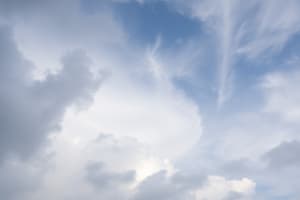Podcast
Questions and Answers
What is the primary cause of wind?
What is the primary cause of wind?
- Changes in humidity levels.
- The Earth's rotation.
- Differences in air pressure. (correct)
- Variations in temperature.
Which atmospheric condition is typically associated with low barometric pressure?
Which atmospheric condition is typically associated with low barometric pressure?
- Rainy weather. (correct)
- Extremely windy weather.
- Cool, dry weather.
- Clear, sunny weather.
If a weather forecast predicts sleet, what type of precipitation should you expect?
If a weather forecast predicts sleet, what type of precipitation should you expect?
- Slush-like frozen rain. (correct)
- A mixture of rain and snow.
- Liquid rain that freezes upon impact.
- Heavy snowfall.
What is the scientific study of cloud formation and its relationship to weather called?
What is the scientific study of cloud formation and its relationship to weather called?
Which of the following best describes the relationship between weather and climate?
Which of the following best describes the relationship between weather and climate?
In which direction does a 'northerly' wind blow?
In which direction does a 'northerly' wind blow?
What are the two main components that form clouds?
What are the two main components that form clouds?
Under what conditions does snow typically occur?
Under what conditions does snow typically occur?
Why is humidity often described as making the air feel 'sticky'?
Why is humidity often described as making the air feel 'sticky'?
Which of these is the force exerted by the weight of air above a given point?
Which of these is the force exerted by the weight of air above a given point?
Which factor contributes to the uniqueness of each cloud?
Which factor contributes to the uniqueness of each cloud?
What term describes the process of liquid or solid water falling from clouds to the Earth?
What term describes the process of liquid or solid water falling from clouds to the Earth?
What is the critical difference between sleet and snow?
What is the critical difference between sleet and snow?
If the forecast predicts rising barometric pressure, what weather conditions are likely?
If the forecast predicts rising barometric pressure, what weather conditions are likely?
What aspect of the atmosphere does 'weather' primarily describe?
What aspect of the atmosphere does 'weather' primarily describe?
Which gas is most closely associated with the concept of humidity?
Which gas is most closely associated with the concept of humidity?
Which of the following professions focuses on understanding cloud formation to improve weather prediction?
Which of the following professions focuses on understanding cloud formation to improve weather prediction?
What is the state of the atmosphere made up of?
What is the state of the atmosphere made up of?
If the wind is named 'Easterly' what does that imply?
If the wind is named 'Easterly' what does that imply?
What happens to frozen rain to produce snow?
What happens to frozen rain to produce snow?
Flashcards
Earth's Atmosphere
Earth's Atmosphere
The mixture of invisible gases surrounding Earth where weather occurs.
Weather
Weather
The day-to-day condition of the atmosphere.
Climate
Climate
The average weather conditions in an area over a long period.
Wind
Wind
Signup and view all the flashcards
Humidity
Humidity
Signup and view all the flashcards
Wind Direction
Wind Direction
Signup and view all the flashcards
Barometric Pressure
Barometric Pressure
Signup and view all the flashcards
Precipitation
Precipitation
Signup and view all the flashcards
Clouds
Clouds
Signup and view all the flashcards
Sleet
Sleet
Signup and view all the flashcards
Snow
Snow
Signup and view all the flashcards
Meteorologists
Meteorologists
Signup and view all the flashcards
Low barometric pressure
Low barometric pressure
Signup and view all the flashcards
High barometric pressure
High barometric pressure
Signup and view all the flashcards
Study Notes
- Weather occurs in the Earth's atmosphere, a mixture of invisible gases surrounding the planet.
- Weather is the daily condition of the atmosphere.
- Climate describes weather patterns over time.
- Wind is air movement due to differences in air pressure.
- Humidity is the water vapor content in the air.
- A wind's name indicates the direction from which it blows.
- Barometric pressure is the force of gases exerted downwards by gravity.
- Low barometric pressure is associated with rainy weather.
- High barometric pressure indicates clear, sunny weather.
- Precipitation is liquid or solid water falling from clouds to Earth.
- Clouds are composed of water droplets and ice crystals.
- Sleet is a slushy form of frozen rain.
- Snow forms when frozen rain reaches the ground.
- Wind, temperature, and water content make each cloud unique.
- Meteorologists study cloud formation to better understand weather.
Studying That Suits You
Use AI to generate personalized quizzes and flashcards to suit your learning preferences.




